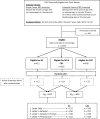Get screened: a randomized trial of the incremental benefits of reminders, recall, and outreach on cancer screening
- PMID: 24002626
- PMCID: PMC3889981
- DOI: 10.1007/s11606-013-2586-y
Get screened: a randomized trial of the incremental benefits of reminders, recall, and outreach on cancer screening
Abstract
Background: Rates of breast cancer (BC) and colorectal cancer (CRC) screening are particularly low among poor and minority patients. Multifaceted interventions have been shown to improve cancer-screening rates, yet the relative impact of the specific components of these interventions has not been assessed. Identifying the specific components necessary to improve cancer-screening rates is critical to tailor interventions in resource limited environments.
Objective: To assess the relative impact of various components of the reminder, recall, and outreach (RRO) model on BC and CRC screening rates within a safety net practice.
Design: Pragmatic randomized trial.
Participants: Men and women aged 50-74 years past due for CRC screen and women aged 40-74 years past due for BC screening.
Interventions: We randomized 1,008 patients to one of four groups: (1) reminder letter; (2) letter and automated telephone message (Letter + Autodial); (3) letter, automated telephone message, and point of service prompt (Letter + Autodial + Prompt); or (4) letter and personal telephone call (Letter + Personal Call).
Main measures: Documentation of mammography or colorectal cancer screening at 52 weeks following randomization.
Key results: Compared to a reminder letter alone, Letter + Personal Call was more effective at improving screening rates for BC (17.8 % vs. 27.5 %; AOR 2.2, 95 % CI 1.2-4.0) and CRC screening (12.2 % vs. 21.5 %; AOR 2.0, 95 % CI 1.1-3.9). Compared to letter alone, a Letter + Autodial + Prompt was also more effective at improving rates of BC screening (17.8 % vs. 28.2 %; AOR 2.1, 95 % CI 1.1-3.7) and CRC screening (12.2 % vs. 19.6 %; AOR 1.9, 95 % CI 1.0-3.7). Letter + Autodial was not more effective than a letter alone at improving screening rates.
Conclusions: The addition of a personal telephone call or a patient-specific provider prompt were both more effective at improving mammogram and CRC screening rates compared to a reminder letter alone. The use of automated telephone calls, however, did not provide any incremental benefit to a reminder letter alone.
Comment in
-
Capsule commentary on Fortuna et al., get screened: a randomized trial of the incremental benefits of reminders, recall, and outreach on cancer screening.J Gen Intern Med. 2014 Jan;29(1):177. doi: 10.1007/s11606-013-2644-5. J Gen Intern Med. 2014. PMID: 24197634 Free PMC article. No abstract available.
References
-
- Cancer screening—United States, 2010. MMWR Morb Mortal Wkly Rep. 2012;61(3):41–5. - PubMed
-
- Sabatino SA, Lawrence B, Elder R, et al. Effectiveness of interventions to increase screening for breast, cervical, and colorectal cancers: nine updated systematic reviews for the guide to community preventive services. Am J Prev Med. 2012;43(1):97–118. doi: 10.1016/j.amepre.2012.04.009. - DOI - PubMed
-
- Fiscella K, Humiston S, Hendren S, et al. A multimodal intervention to promote mammography and colorectal cancer screening in a safety-net practice. J Natl Med Assoc. 2011;103(8):762–8. - PubMed
Publication types
MeSH terms
Grants and funding
LinkOut - more resources
Full Text Sources
Other Literature Sources
Miscellaneous


